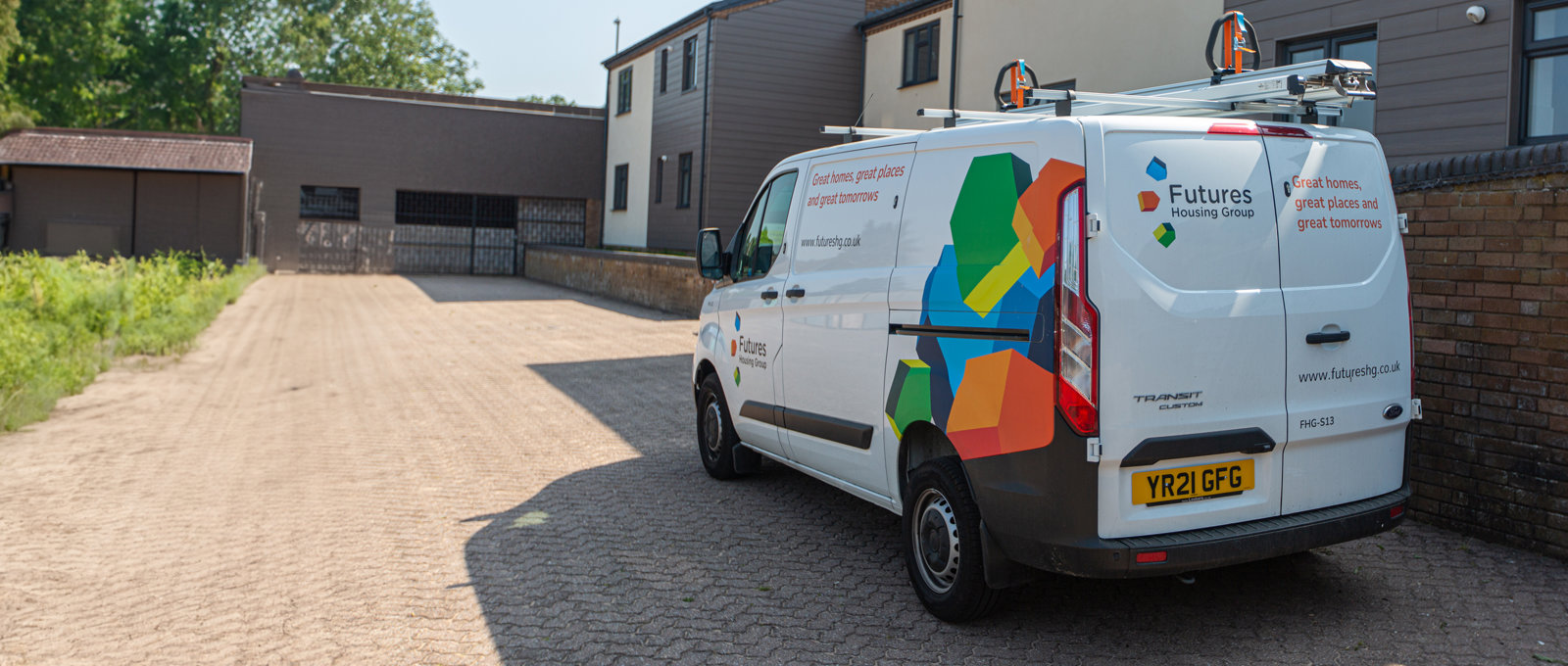Keeping your home in good condition
is important to us
Homes are complicated with thousands of components that can and do fail. While some faults are just inconvenient others can be life-threatening. Many issues are quick and simple to put right; others can be challenging, expensive and time consuming to deal with.
With well over 10,000 houses and flats to take care of, we have our work cut-out to keep everyone’s home in a good, safe and comfortable condition. But it’s one of our biggest priorities.
Understanding how we repair and maintain our customers’ homes can help you to get the best out of our repairs service.
How we prioritise your repair
Any fault in your home can be annoying so we know it’s important to fix things as quickly as we can. But we also need to make sure that we deal with the most serious issues, especially those that can be dangerous, first. Alongside this we need to take extra care of customers who may be particularly vulnerable. And there are some things that we expect you to deal with yourself as a tenant.
To help us make sure that we are prioritising the most urgent jobs and the most vulnerable, we categorise faults, repairs and maintenance into five groups:

There are some faults in your home that you need to take care of yourself.
Examples of things in this category include:
- replacing toilet seats, light bulbs or shower heads
- fixing small plaster cracks
- maintaining boundary fences (where you are responsible as the customer - which isn't always the case).
Click here to view or download a full list of all the faults that you are responsible for dealing with yourself.
You can also get lots of help and advice, including simple 'how-to' video guides, about lots of minor DIY repairs on our Help Hub.

If you have a fault or issue in this category we will come to your home on the same day that you report it to us to make it safe although further visits may be necessary to fully resolve the problem.
This category of repairs includes issues such as:
- faulty carbon monoxide or smoke alarms
- no working toilet in the home
- total loss of power
- window and door repairs to make your home secure.
Click here to view or download a full list of all the faults that we classify as priority repairs.

We aim to resolve these issues within this category in four working days or less.
Faults treated as fast repairs are things such as:
- boiler faults leaving you without heating or hot water
- making sure you have a working bath or shower (when you have no other way of bathing)
- failure of one of the electrical circuits in your home.
Click here to view or download a full list of all the faults and issues that we classify as fast repairs.

This basically covers all other faults and issues that don't fit into the priority and fast categories or that we don't expect you to take care of yourself.
We normally resolve these within 10 – 25 days although some issues may take longer.
Examples of standard repairs include:
- a dripping tap
- containable leaks
- a fault with a single light fitting.
If you don't want to wait for us to come and fix your issue, it may be something that you can sort our yourself. Check out our Help Hub for information, and advice on DIY repairs.

If something in your home needs a full replacement it will be scheduled into our planned works programme. This covers things such as upgrades to:
- kitchens
- bathrooms
- heating systems
- roofs
- windows.
If we find out that a full replacement is needed on a repair visit we will fix the problem for the time being then plan to carry out the full work at a later date.
We also survey all our homes every few years and plan in major upgrades and replacements as part of a rolling programme of scheduled work.
Find out more about planned works here.
Other things to know about repair times
- We can deal with issues more quickly than normal if someone in the household is vulnerable so it’s important to tell us if you or other family members fall into this category – for example, the very young or old and people with serious or long-term health conditions.
- Repairs may take longer than expected if parts or materials are unavailable. We will do everything we can to complete the work as quickly as possible but supply chain problems are often outside our control.
- Sometimes when we investigate a fault we may discover that you really need a full replacement or upgrade. This would typically be for things like heating systems, kitchens, bathrooms, windows and roofs. When this is the case we will fix the immediate problem and make things safe, but then plan to carry out the replacement in the future. The work then goes into our planned works programme - and means you can expect to wait up to a year for the upgrade to happen. Click here to find out more about planned works and how we invest in keeping homes up-to-date and modern. If the fault comes back or things get worse while you are waiting for an upgrade, please do let us know.
Help us to help you
There are some simple things you can do to help us to get your repairs dealt with more quickly.
- Make sure we have your up-to-date contact details so that we can get in touch to make arrangements when we need to.
- Be at home when we’ve made an appointment to carry out repairs or tell us you’re going to be out as soon as possible if it’s unavoidable so that we can rearrange. That saves us time that we can use to help the next customer.
- Use MyAccount and the repairs checker (see the green button above) rather than calling – it’s usually quicker.
- If you do miss an appointment for a repair and we can’t get into your home to do the work, the job will be cancelled. If you still need help you must contact us to rearrange or we won’t come back and the problem won’t be dealt with.
- Be aware that we can’t specify an appointment time for fast or priority repairs so you will need to be prepared to be at home all day. However, for other, less urgent repairs you can chose a morning, afternoon, anytime or ‘avoiding school runs’ slot.
How to get in touch
Our customer contact team are your first port of call when you have a fault in your home that we need to fix. There are many ways to get in touch with them:
- Log in to MyAccount
- Fill out our customer enquiries form.
- Use the live chat on our homepage in the pop-up box in the bottom right corner when we’re online.
- Call 0300 456 2531. Our phones are open from 8:30am to 5pm Monday to Thursday and 8:30am to 4:30pm on Fridays. If we’re busy, you can use the call-back option and you won’t lose your place in the queue. If you hang up and call again you will go to the back of the queue once more.
- Outside our normal opening hours (eg at weekends) we only offer an emergency call-out service. This service will only treat hazardous problems to make your home safe again and is not a full repairs service.

We have a standard process that we follow when you report a repair. The process is the same, but the priority level and speed of response will depend on the type of fault.
- We’ll assign a member of the repairs team to your request.
- We’ll send you a text message to confirm your appointment.
- We’ll send you a reminder message each week in the run-up to your appointment.
- We'll send a final reminder to you 48 hours before the appointment.
- We'll let you know when a member of the team is on their way to you.
- Our team will visit and carry out the repair.
- Wherever possible we will fix the problem on our first visit but sometimes we may need to make a follow-on appointment (for example where we need to order spare parts to finish the job). If this happens we will always leave your property in a safe condition and aim to complete the work as soon as possible.
- If we find, when carrying out a repair, that a full replacement is due, we will schedule this into our planned works programme.

When you move into a Futures home there we have a checklist against which we evaluate the property before handing over the keys.
This sets out what you can expect when you arrive.
View or download a copy of the lettable standard here.

Condensation is produced when warm humid air touches a cold surface. It can be caused by everyday activities in your home such as having a shower, washing and drying clothes or boiling a kettle.
If condensation forms where there is little or no ventilation, it can cause a black mouldy-looking growth to form. Don’t worry if this happens, just follow these simple steps to prevent and treat it:
Produce less moisture by:
- using lids on saucepans to reduce steam
- avoiding using radiators to dry clothes
- venting tumble driers to an open window or outside.
Stop moisture spreading by:
- opening windows or using an extractor fan when you are cooking or washing
- keeping windows open for 20 minutes after this kind of activity - until the damp air has cleared away
- wiping away condensation when it appears.
Ventilate moisture by:
- opening your window vents when inside a room
- leaving gaps between furniture and walls
- avoiding overfilling wardrobes and drawers.
Provide even heating by:
- keeping your home warm to prevent condensation forming
- leaving your heating on lower for longer
- keeping all rooms heated, including ones you don’t use.
Treat mould caused by condensation by:
- acting straight away to prevent it spreading
- sterilising the affected area with a fungicidal wash and keep an eye on it – if it comes back, treat it again.
- painting the affected area with some fungicidal paint after it has cleared or, if using wallpaper, use paste with fungicidal properties
- dry clean carpets or clothes with mould growing on them (vacuuming or brushing the mould can be hazardous to your health).
Prevent mould from forming by wiping up any condensation you see in your home.

Asbestos has not been used in the UK as a building material since the early 1980s. It is not dangerous if it is in good condition but can cause serious illness if it is broken up and inhaled.
Most asbestos has either been removed from our properties or is contained safely in:
- gutters and rain water downpipes
- soffit boards, boarding under canopies
- textured paints and Artex
- flat corrugated roof or wall sheets, especially garages
- cold water tanks
- roof slates, felts and linings
- bath panels
- roof and wall cladding
- some storage heaters
- internal partitions.
We have carried out a thorough asbestos survey and keep a register of properties which contain asbestos.
If any asbestos materials, or materials that you think may contain asbestos, become damaged or you wish to carry out DIY work that could disturb asbestos, please contact our Asset Management Team immediately on 0300 456 2531.







